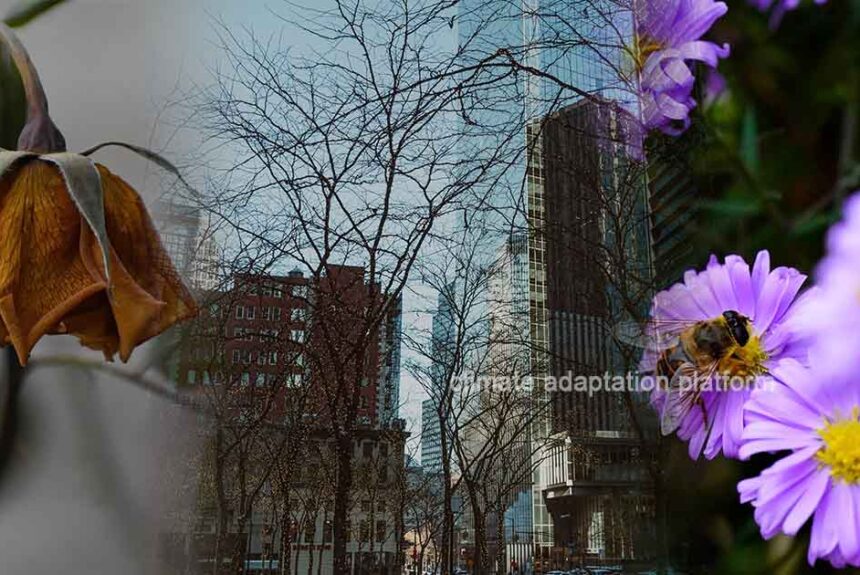While ornamental flowers and brightly coloured blooms are often prioritised in public and city gardens for their visual appeal, it is equally important to balance aesthetics with environmental benefits.
Calvert Vaux Park in Brooklyn, one of the city’s most significant bee habitats, was once home to a rose garden. Since roses are not native to the region, they have been replaced with native pollinator species such as mountain mint, coneflowers, and milkweed.
These plants attract a variety of bees, birds, and other pollinating animals, much to the delight of the local community. This initiative is part of New York City’s efforts to revive the declining pollinator population.
New York City’s Pollinator Decline
Inside Climate News discusses various initiatives in New York City aimed at attracting and increasing the population of pollinators. The city is experiencing a decline in these critical species. A 2022 survey revealed that 38% of native pollinators included in the study are at risk of regional extinction, with flies and bees being the most vulnerable.
This decline is attributed to the effects of climate change, which are altering rainfall patterns, causing floods, and destroying habitats through wildfires. Urban development, particularly the clearing of vegetation and paving the soil with impermeable materials, the spread of parasitic mites, and the use of pesticides that kill native pollinator plants, also contribute to pollinator habitat loss.
As the temperature warms earlier in the year, it also means that flowers can bloom before the bees have left their winter nests, reducing opportunities for pollination.
Citywide Initiatives to Support Pollinators
To increase the number of pollinators in New York City, the city has implemented several initiatives.
The Department of Parks and Recreation’s Pollinator Place programme has encouraged the planting of pollinator-friendly species and has created 23 pollinator gardens across the city since 2021.
These 23 Pollinator Place gardens are found across New York City’s five boroughs – the Bronx, Queens, Brooklyn, Manhattan, and Staten Island. NYC Parks provides detailed information on where these gardens are located.
Non-profits like the New York Restoration Project and The Horticultural Society of New York create and maintain small private gardens that support bees, butterflies and other pollinators, as well as street planters, some of which have been fitted with bee “hotels” to serve the native bee population.
Why Pollinators Matter
According to the article, “Pollinators are essential for the reproduction of flowering plants, transferring genetic material between them that enables fertilisation, which leads to the production of seeds and fruit.”
For many years, scientists have been worried about the global decline in biodiversity, especially among insects. Recent studies confirm that insect populations are facing significant threats. A 2021 study shows that in Central Europe, over 40% of native insect species are at risk of extinction, according to the IUCN Red List.
This decline is primarily caused by habitat loss and fragmentation resulting from intensified farming and urban development. While there is a strong link between intensive agriculture and pollinator decline, the study reveals a dearth of information regarding the impact of urbanisation on insect diversity.
What Science Says About Ornamental Plants and Pollinators
Urban areas are home to a diverse range of flowering plants, both native and exotic, and these plants play a vital role in supporting pollinators, such as bees.
To determine how well ornamental plants can support pollinator populations, the study established flower beds at 13 urban locations in Stuttgart, Germany, with the same types of garden plants and observed pollinator visits over two summers. The authors recorded a total of 10,565 pollinators, with wild bees making up more than 50% of them.
Their findings revealed that a variety of ornamental plants attracted a large number of urban pollinators seeking pollen and nectar. The number and types of pollinators varied significantly between different plant species and even among different cultivars.
Additionally, more pollinators were observed around plants with more flowers. Overall, their findings show that ornamental plants are friendly or attractive to pollinators.
Pollinator-Friendly Choices for Cities
These ornamental plants have also provided a valuable food source for many pollinators in urban areas, especially wild bees, which are often seen collecting pollen and nectar. However, some pollinators, such as hoverflies, do not find these plants helpful.
The research is one of the first to provide information regarding the type of plant species and the pollinators they attract, and recommends planting these pollinator-friendly species in urban parks, gardens, and allotments.
The study concludes that urban and suburban areas have potential for pollinator habitats, but careful selection of plants is necessary. This selection must consider the suitability of the location and the pollinator-friendliness of the plants.
Source:
Dalban, L. (2025, June 30). Helping Bees Find New Homes Across New York City, From Fresh Kills to Street Planters. Inside Climate News. Retrieved from https://insideclimatenews.org/news/30062025/new-york-city-bee-habitats/
Pollinator Place Gardens. NYC Parks. Retrieved from https://www.nycgovparks.org/highlights/pollinator-place-gardens
Marquardt, M., Kienbaum, L., Kretschmer, L.A. et al. Evaluation of the importance of ornamental plants for pollinators in urban and suburban areas in Stuttgart, Germany. Urban Ecosyst 24, 811–825 (2021). https://doi.org/10.1007/s11252-020-01085-0



Leave a Reply